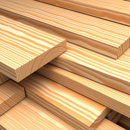Home & Leisure
/ArcaMax

Here's How: There Are Many Types and Grades of Lumber
Dear James: I went out to buy some lumber for some home projects. I was overwhelmed by the different kinds of lumber. What do the different grades and types of lumber mean? -- Bobbi T.
Dear Bobbi: Lumber is more than just a tree cut up into boards. There are many species of trees with different characteristics. Also, the methods in which the ...Read more

Here's How: Using an Interior Designer Is a Wise Choice
Dear James: We plan to have a house built. I think I have a pretty good eye for design and decor, but do you think it is still a good idea to hire an interior designer? -- Bernie G.
Dear Bernie: In addition to looking through magazines and visiting home shows yourself to get an idea of what you want, involving an interior designer does make ...Read more

Here's How: How To Install Beautiful Parquet Flooring
Dear James: I'm on a limited budget, but I would like a parquet hardwood floor in my dining. Is that a project I can do myself to reduce the overall cost? -- Judy S.
Dear Judy: You will find parquet flooring "kits" which are intended for the average do-it-yourselfer. It is much easier to lay a parquet floor than a standard strip floor. The ...Read more

Here's How: Smoke-Free Chimney Starts With Correct Design
Dear James: My fireplace does not draw well, and the room gets smoky sometimes. I am adding another fireplace. What construction tips are important so the flue draws better? -- Tyler F.
Dear Tyler: Your smoking wood-burning fireplace in your living room unfortunately is a very common problem. Once a room has filled with smoke from a fireplace, ...Read more

Here's How: Complete Wood With French Polish Finish
Dear James: My old house has gorgeous natural cherry woodwork. I plan to refinish with natural French polish finish. Will it hold up? And what is the best way to apply it? -- Dawn B.
Dear Dawn: Cherry wood is a beautiful color with nice graining. It also is a fairly hard wood, so it likely is still in pretty good condition. Once the old finish ...Read more

Here's How: Save by Installing Your Own Carpeting
Dear James: Our wall-to-wall carpeting is looking its age, and it should be replaced. I would like to save the installation costs. Can installing it be a DIY project? -- Bruce R.
Dear Bruce: It definitely can be a DIY project, particularly in a basically rectangular room. Removing and disposing of the old carpeting and preparing the floor can ...Read more

Here's How: Circuit Breakers Protect House Wiring
Dear James: I am concerned about a fire from an electrical issue in my older house. What are the differences among fuses, breakers, GFCI and AFCI, and which are best? -- Peggy T.
Dear Peggy: You are wise to be concerned about an electrical fire from old or new wiring. One the most dangerous aspects of electrical fires is they often start inside...Read more

Here's How: Tips for Pouring Concrete Driveway
Dear James: I plan to have my asphalt driveway replaced with concrete. My neighbor's cracked after on a few years. What should the contractor to do so mine holds up? -- Dave S.
Dear Dave: Your driveway is the first thing that most people see when visiting your house, and a deteriorated one can be a real eyesore. If installed with the proper ...Read more

Here's How: An Air/Water Barrier Stops Wood Rot
Dear James: I am planning a new room addition to our home. I have heard a lot about serious rotting of the lumber in the walls. How can we be sure to avoid the moisture and frame rotting problems? -- Beth R.
Dear Beth: Moisture damage can be a serious problem, but there are several methods to block the moisture to eliminate possible damage. ...Read more

Here's How: Relax in Your Home Steam Room
Dear James: It feels good in a steam room and I hear it is healthy, but I hake having to drive to the gym for it. What is involved in converting my shower stall into a steam room? -- Chris K.
Dear Chris: It can be extremely relaxing taking a steam at home after a long day at the office or an active day with some tired muscles. Contrary to ...Read more

Here's How: Woodwork Trim Can Transform a Room
Dear James: My living room needs a decor update. I'm on a limited budget and plan to do it myself. Would adding some woodwork help? I will need some installation tips. -- JoAnn T.
Dear JoAnn: Attractive woodwork trim can make a dramatic improvement in your living room decor. It can be difficult to find unique-looking baseboard, crown molding ...Read more

Here's How: Professional Window Cleaning Tips
Professional Window Cleaning Tips
Dear James: My new house has many windows and I have a problem cleaning them without leaving streaks, especially on the south-facing ones. How do professionals clean them? -- Alex J.
Dear Alex: You probably had streak-free windows when you moved in. This is because the builder likely hired a professional ...Read more

Here's How: Add a Window Seat for Storage
Dear James: We could certainly use some additional storage space in our bedrooms. As kids, we used to have window seats for storage. What are some simple design options? -- Angela B.
Dear Angela: Window seats are not as popular in modern homes as they used to be, but they are an excellent option for additional bedroom storage space. The space ...Read more




























